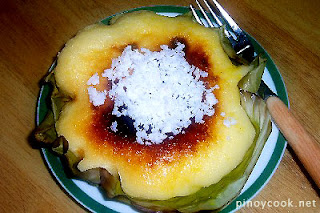No Filipino Christmas is ever without
bibingka. They are inexorably associated with
misa de gallo, the dawn mass on the nine days before Christmas. While they are more common as street food, they are so popular (even among tourists) that even five-star hotels serve them–using the traditional cookware–during the holiday season.
Bibingka, above, is a rice cake similar to the Western pancake in appearance. In taste, texture and way of cooking, however, they are very much different from each other.
Bibingka is made from
galapong, baked in a special clay pot, lined with a piece of banana leaf, with live coals on top and underneath. It is topped with slices of
kesong puti (white cheese) and
itlog na maalat (salted duck eggs). The newly-cooked
bibingka is spread with butter and sometimes sprinkled with sugar then served with
niyog (grated coconut).
Galapong is glutinous rice soaked in water then ground with the water to form either a batter or a dough, depending on what the cooked dish is supposed to be.
Ingredients
4 eggs, well beaten
2 cups coconut milk
1 cup sugar
1/4 cup melted margarine
2 cups rice flour
2 tablespoons baking powder
1/2 teaspoon salt
1/4 cup coco cream, 1/4 cup sugar for topping
<>Add sugar to beaten eggs. Combine salt and flour; add to egg mixture. Add melted margarine, coconut milk, and baking powder. Pour into banana leaf-lined mold. Bake in 375 degrees Fahrenheit oven. When half-done, take it out from the oven and brush top with coconut cream and sugar and bake until golden crust is formed. Yield: 3 large bibingkas.








No comments:
Post a Comment